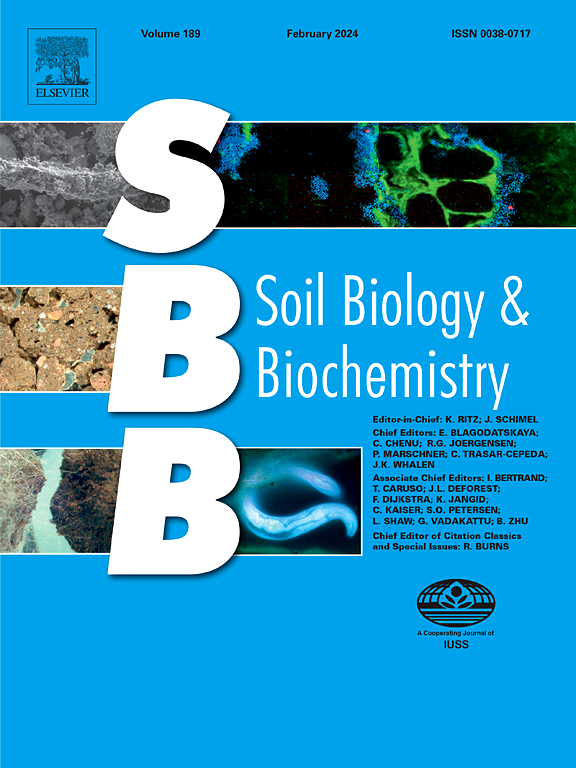Land-use driven changes in elemental stoichiometry decouple the positive soil biodiversity-stability relationship
IF 10.3
1区 农林科学
Q1 SOIL SCIENCE
引用次数: 0
Abstract
Land-use intensification often reduces aboveground biodiversity and ecosystem stability, but its effects on belowground biodiversity across multiple trophic levels and spatial scales, as well as their links to ecosystem stability, remain poorly understood. In this study, we conducted a field survey to assess the α-, β-, and γ-diversity of soil biota (bacteria, fungi, and nematodes) and estimated the temporal ecosystem stability using normalized difference vegetation index (NDVI) along a land-use intensity (forests, orchards, croplands) across 44 sites in subtropical regions. Agricultural land conversion significantly reduced α-, β-, and γ-diversity of soil biota across trophic levels, with higher trophic levels (e.g., microbivorous and omnivorous-predaceous nematodes) more affected than lower ones (e.g., microbes). Soil biodiversity, defined as the average diversity of all soil biota groups, was positively related to the temporal stability of plant productivity, with the higher trophic levels playing a greater role at all scales. However, land-use intensification decoupled the positive relationships between soil biodiversity and the temporal stability at both local and regional scales. Further analyses revealed that changes in soil elemental stoichiometry, particularly the carbon to phosphorus ratio, were a predominant driver of soil biodiversity loss at both local and regional scales, as well as its relationship with the temporal stability. These findings highlight the importance of elemental stoichiometry in shaping biodiversity-stability relationships and provide insights into the impacts of land-use intensification on soil communities and ecosystem resilience.


土地利用驱动的土壤元素化学计量变化使土壤生物多样性-稳定性的正相关关系解耦
土地利用集约化往往会降低地上生物多样性和生态系统稳定性,但其对地下生物多样性在多个营养水平和空间尺度上的影响,以及它们与生态系统稳定性的联系,仍知之甚少。通过野外调查,研究了亚热带44个样地土壤生物群(细菌、真菌和线虫)的α-、β-和γ-多样性,并利用归一化植被指数(NDVI)估算了不同土地利用强度(森林、果园、农田)下土壤生态系统的时间稳定性。农用地转换显著降低了不同营养水平土壤生物群的α-、β-和γ-多样性,高营养水平(如微食性线虫和杂食性捕食线虫)比低营养水平(如微生物)受影响更大。土壤生物多样性是指所有土壤生物群的平均多样性,其与植物生产力的时间稳定性呈正相关,在所有尺度上,营养水平越高,作用越大。然而,土地利用集约化在局地和区域尺度上都使土壤生物多样性与时间稳定性之间的正相关关系解耦。进一步分析表明,土壤元素化学计量的变化,特别是碳磷比的变化,是土壤生物多样性在局地和区域尺度上丧失的主要驱动因素,以及其与时间稳定性的关系。这些发现强调了元素化学计量在形成生物多样性-稳定性关系中的重要性,并为土地利用集约化对土壤群落和生态系统恢复力的影响提供了见解。
本文章由计算机程序翻译,如有差异,请以英文原文为准。
求助全文
约1分钟内获得全文
求助全文
来源期刊

Soil Biology & Biochemistry
农林科学-土壤科学
CiteScore
16.90
自引率
9.30%
发文量
312
审稿时长
49 days
期刊介绍:
Soil Biology & Biochemistry publishes original research articles of international significance focusing on biological processes in soil and their applications to soil and environmental quality. Major topics include the ecology and biochemical processes of soil organisms, their effects on the environment, and interactions with plants. The journal also welcomes state-of-the-art reviews and discussions on contemporary research in soil biology and biochemistry.
 求助内容:
求助内容: 应助结果提醒方式:
应助结果提醒方式:


